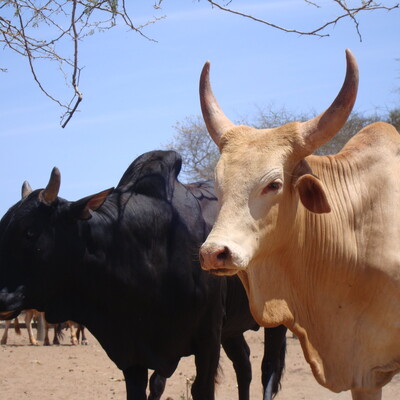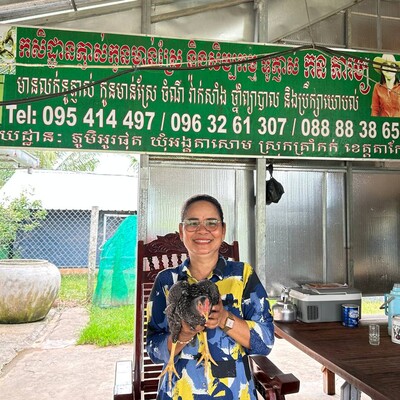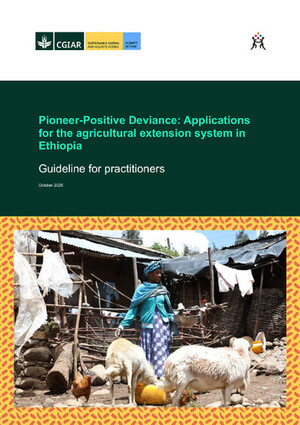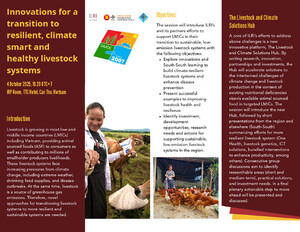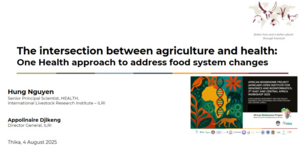
Thursday Links (11 April 2019)
A monthly round-up of recent articles, blog postings and tweets about livestock, aid and other topics that may be of interest to ILRI staff and partners, compiled by David Aronson.
AMR
The New York Times series on antibiotics and the rise of AMR leads this month’s Thursday Links. This piece on the emergence of candida auris, a new drug-resistant infection, will make you want to stay out of the hospital forever, no matter how sick you get. It’s probably not a good thing when the top epidemiologist from the CDC says, of the germ’s murky origins: ‘It is a creature from the black lagoon.’ (The article goes on to report speculation that it emerged thanks to heavy use of fungicides on crops.)
This follow-up story on overuse of generic antibiotics in Kibera brings the story close to home: ‘Kibera residents are prodigious consumers of antibiotics. One study found that 90 percent of households in Kibera had used antibiotics in the previous year, compared with about 17 percent for the typical American family.’
The Meat Debate
In a longish article on our moral obligations to animals in the New York Review of Books, Thomas Nagel (What is it like to be a bat?) concludes:
Whether we should kill animals for food is one of the deepest disagreements of our time; but we should not be surprised if the issue is rendered moot within the next few decades, when cultured meat (also called clean meat, synthetic meat, or in vitro meat) becomes less expensive to produce than meat from slaughtered animals, and equally palatable. When that happens, I suspect our present practices, being no longer gastronomically necessary, will suddenly become morally unimaginable.
More:
At Vox.com, Melanie Joy predicts that in 50 years, eating meat will have become nearly unthinkable: ‘In 50 years, I believe more and more of us will have been freed from the matrix of carnism, and we’ll look back at this moment and wonder why we ever consumed so many animals.’

Over at The Conversation, Frank M. Mitloehner, professor at UC-Davis, argues that the claim that meat production generates more greenhouse gases globally than the entire transportation sector is demonstrably wrong. He’s also the author of the above graph, on meat and nutrition.
Vegetarianism used to be a fairly ecumenical life choice; these days, at least in the U.S., it’s becoming fraught with partisanship. This article shows how Representative Alexandria Ocasio-Cortez, a prominent young congressperson from New York, ended up walking back some of her original anti-meat claims when presented with counter-evidence from UC-Davis’ Mitloehner. The moral of the story: Evidence-based advocacy can, sometimes, be effective—depending on how open-minded the policymaker is.
The Guardian reviews many of the reasons (climate change/ethical consumption) to eat less meat in an article titled “Have we hit ‘peak beef’?”
Another problem with meat, says The Guardian: The prodigious amount of poo it produces. Billions of tonnes of excrement are starting to poison the natural world, it says.
The Intercept has a new video series out titled Animal Matters, about the alleged horrors of factory farming. ‘With remarkable speed,’ it says, ‘the cause of animal rights and the abuses of industrial animal agriculture have been catapulted from fringe left-wing activist circles to the center of a wide range of non-ideological policy, ethical, environmental, political, and moral debates.’
Conflict News
In the single worst attack of its kind in recent memory, 134 Fulani were killed in the villages of Ogossagou and Welingara in central Mali in the early morning hours of March 23.
This attack is part of a deeply worrying trend: The Armed Conflict Location and Event Data Project (ACLED) reports that, ‘Over the last five months, there has been an increase in both fatalities and conflict events in the region, with nearly 5,000 reported fatalities and more than 1,200 violent events recorded by ACLED. This represents an increase of 46% and 31% respectively relative to the same period the previous year.’
ILRI’s Fiona Flintan, a rangelands governance scientist, led a webinar recently on how best to secure land tenure for pastoralists, based on her work in Ethiopia and Tanzania.
Other News:
A long article in African Business Magazine, titled Raising the Steaks, provides a comprehensive overview of the risks and opportunities presented by Africa’s livestock sector and features extensive analysis from ILRI’s Jimmy Smith. Smith also gave an thorough overview of the livestock sector in the developing world at the Borlaug Summer Institute at the Purdue Center last year, with a host of slides outlining the sector’s challenges and opportunities.
A podcast examines the scientific basis for claims that soy, almond and oak milk are better than cow’s milk. TL;DR: Switching to soy would save half a billion hectares of land and almost a billion tonnes of greenhouse gases a year. What the podcast omits: How to get that soy into the bellies of babies living in poorer countries—or provide alternate livelihoods for the half billion people who depend on livestock.
An article from Le Soir on the future of lab meat (in French).
And in Le Monde is a nice profile of a high-tech biotechnology lab in Central African Republic studying deadly emerging viruses (in French).
Burger King, the world’s second largest fast food/hamburger restaurant chain in the world, with 7,200 outlets, is introducing a whopper made with a vegetarian patty from the start-up Impossible Foods.
An article from the World Economic Forum argues that industrial farming isn’t ‘sustainable for the planet, for individuals or for societies long-term.’ It calls for greater use of agtech, including such devices as facial recognition systems for cows, which is helping to ‘reduce loss and overhead while adding more predictability, and profit, to the job.’
The world’s worst air pollution is found in Ulaanbaatar, Mongolia—where the average temperature has risen by 2.2 Celsius, putting the livelihoods of millions of local pastoralists at risk. The BBC reports.
Still siring after all these years: Sir Freddie the Ram’s 50 year-old frozen sperm is still being used to produce offspring.
Iceland’s rams are advertising in an online registry, said to be ‘one of the most eagerly-anticipated publications among Iceland’s sheep farmers and enthusiasts’.
Goats: What can’t they be used for? This Nevada City town is crowdfunding the rental of a grazing goat herd to eat flammable plants on city-owned land.
Europeans used cattle for traction 8,000 years ago—some 2,000 years more than previously thought, say scientists who have studied changes to the footbones of cattle dating from that era.
This article on the global response to the Ebola outbreak in eastern Congo is not on topic, but makes brilliantly the larger point that without local buy-in and trust, even the most well-intentioned projects can go awry. More on the story here.
 A new book on cows is due out soon: “Cows were possibly the first sacred animals in human history,” says author/photographer Werner Lampert. Some truly spectacular photos within.
A new book on cows is due out soon: “Cows were possibly the first sacred animals in human history,” says author/photographer Werner Lampert. Some truly spectacular photos within.
This article from the Financial Times on the million-plus Chinese who have recently emigrated to Africa, seeking new opportunities to replicate the Chinese experience of the 1980s and 1990s here in Africa, is an eye-opening piece—and while it doesn’t focus on livestock or agriculture per se, the implications are worth monitoring. (Paywalled, alas.)
A stray photo of a well-known vegan sampling a fish has gone viral, leaving her vegan fan base furious at her for her alleged ‘betrayal,’ and causing her to lose tens of thousands of followers on social media. More on the story here.
From the Lugar Center: US investment in agriculture used to lead the world. Now it is falling way behind.
People are taking a huge toll on the plains of the Serengeti-Mara, says Joseph Ogutu, a senior statistician at the University of Hohenheim and formerly of ILRI. He writes:
We found that the activities of people have caused extreme changes to the habitat. It has significantly reduced the amount of grass and, because of farms, settlements and fences, the landscape has become fragmented – this means animals can’t move freely to find resources or mate. Key ecological functions have also changed. There are less man-made or wild fires which means that trees and shrubs are able to take root, soils are damaged – and so the land produces less plants – and the area becomes more sensitive to climate change.
A survey of 213 Maasai farmers in southern Kenya found that Maasai scrupulously avoid killing lions, unless the evidence is clear that the lion in question is attacking their livestock. The research is part of ILRI former research associate Enoch Ontiri’s PhD at the University of Exeter.
What do you do if lions keep attacking your cows? If you’re 11-year old Maasai Richard Turere, living near the Nairobi National Park, in Kitengele plain, you come up with Landlights, a new invention for scaring the lions away.
This article from the BBC says that Kenyans chased down and caught live a few goat-eating cheetahs in their neighbourhood by—and this just astounds me—running after them. “I was sipping a cup of tea when I saw them killing another goat,” [the farmer] said, explaining that this was early in the morning. He said he waited until several hours later when the sun was high to go after them. “I called some youths and we ran after them,” he said.” The live (but presumably humbled) cheetah were handed over to local authorities.
Finally, this exquisite piece of writing about having a traditional Maasai meal:










